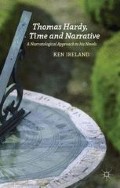Abstract
For many readers, their first and most enduring impression of The Return of the Native (1878) remains the highly sensuous and atmospheric evocation of Egdon Heath at the start. Grouped into ‘Novels of Character and Environment’ in his General Preface to the Wessex Edition of 1912, Hardy’s sixth novel draws much of its colouring and inspiration from that initial framework: in film terms, a salient establishing shot. In terms of its actual scale, the account of Egdon occupies, with one exception, the least space of any chapter (134 lines vs. average of 276), a fact testifying to the degree of its intensity and powerful recall in the imagination of the reader.2 By sharp contrast with the three venues and immediate entry of the heroine at the start of the foregoing HE, the first chapter of RN features no human beings, only Egdon Heath as dominating personality of the natural world.3 As its title intimates (‘A Face on which Time makes but Little Impression’), the chapter appears to be atemporal, reaching back to prehistory and myth from the locus of a twilight Saturday in November. Two chapters later, it is identified as the Fifth, Guy Fawkes’ Night, a date which naturalizes the important bonfire motif of Book First.
[Egdon Heath] was at present a place perfectly accordant with man’s nature — neither ghastly, hateful, nor ugly: neither commonplace, unmeaning, nor tame; but, like man, slighted and enduring; and withal singularly colossal and mysterious in its swarthy monotony. As with some persons who have long lived apart, solitude seemed to look out of its countenance. It had a lonely face, suggesting tragical possibilities.1
To dwell on a heath without studying its meanings was like wedding a foreigner without learning his tongue. The subtle beauties of the heath were lost to Eustacia; she only caught its vapours. An environment which would have made a contented woman a poet, a suffering woman a devotee, a pious woman a psalmist, even a giddy woman thoughtful, made a rebellious woman saturnine.... For the rest, she suffered much from depression of spirits, and took slow walks to recover them, in which she carried her grandfather’s telescope and her grandmother’s hour-glass — the latter because of a peculiar pleasure she derived from watching a material representation of time’s gradual glide away. (pp. 70–1; 1.7)
Access this chapter
Tax calculation will be finalised at checkout
Purchases are for personal use only
Preview
Unable to display preview. Download preview PDF.
Notes
Thomas Hardy, The Return of the Native, ed. Simon Gatrell with Notes by Nancy Barrineau and Introduction by Margaret Higonnet, Oxford World’s Classics (Oxford: Oxford University Press, 2008), p. 11
Michael Millgate, Thomas Hardy: His Career as a Novelist (London: Bodley Head, 1971), p. 142
Lance St John Butler, Thomas Hardy (Cambridge: Cambridge University Press, 1978), p. 32.
Joseph Warren Beach, The Technique of Thomas Hardy (New York: Russell & Russell, 1962), p. 105
Meir Sternberg, Expositional Modes and Temporal Ordering in Fiction (Baltimore and London: Johns Hopkins University Press, 1978), p. 17.
See Ken Ireland, The Sequential Dynamics of Narrative: Energies at the Margins of Fiction (Cranbury NJ and London: Associated University Presses, 2001), pp. 90–4.
See Mikhail Bakhtin, ‘Forms of Time and of the Chronotope in the Novel: Notes towards a Historical Poetics’, in The Dialogic Imagination: Four Essays, ed. Michael Holquist, trans. C. Emerson and Michael Holquist (Austin: University of Texas Press, 1998), pp. 84–258.
See references to the ‘Gothic art-principle’ in Florence Emily Hardy, The Life of Thomas Hardy 1840–1928 (London: Macmillan, 1962), p. 301. Henceforth Life.
RN, p. 415; Carl J. Weber, ‘Chronology in Hardy’s Novels’, PMLA 53.1 (1938), 314–20
F. B. Pinion, A Hardy Companion (London: Macmillan, 1968), p. 31.
See Dale Kramer, Thomas Hardy: The Forms of Tragedy (London: Macmillan, 1975), p. 49.
See Sheila Berger, Thomas Hardy and Visual Structures: Framing, Disruption, Process (New York: New York University Press, 1990), p. 114.
John Paterson, The Making of ‘The Return of the Native’ (Westport, CT: Greenwood Press, 1978), pp. 164–7.
D. H. Lawrence, Study of Thomas Hardy and other Essays, ed. Bruce Steele (London: Grafton Books, 1986), p. 46.
Jeannette King, Tragedy in the Victorian Novel: Theory and Practice in the Novels of George Eliot, Thomas Hardy and Henry James (Cambridge: Cambridge University Press, 1978), p. 107.
See Ronald W. Langacker, Foundations of Cognitive Grammar (Stanford, CA: Stanford University Press, 1987), pp. 116–37.
See David Herman, ‘Cognition, Emotion, and Consciousness’, in Herman, ed., The Cambridge Companion to Narrative (Cambridge: Cambridge University Press, 2007), pp. 245–59
Jean R. Brooks, Thomas Hardy: The Poetic Structure (London: Elek, 1971), p. 183
Raymond Chapman, ‘The Reader as Listener: Dialect and Relationships in The Mayor ofCasterbridge’, in Leo Hickey, ed., The Pragmatics of Style (London: Routledge, 1989), pp. 159–78
John L. Locke, Eavesdropping: An Intimate History (Oxford: Oxford University Press, 2010), p. 196.
Ann Gaylin, Eavesdropping in the Novel from Austen to Proust (Cambridge: Cambridge University Press, 2002)
For Perry Meisel, Thomas Hardy: The Return of the Repressed: A Study of the Major Fiction (New Haven & London: Yale University Press, 1972), p. 76
Bert G. Hornback, The Metaphor of Chance: Vision and Technique in the Works of Thomas Hardy (Athens, OH: Ohio University Press, 1971), p. 17
Copyright information
© 2014 Ken Ireland
About this chapter
Cite this chapter
Ireland, K. (2014). From Jewels to Furze: Transience and Permanence in The Return of the Native. In: Thomas Hardy, Time and Narrative. Palgrave Macmillan, London. https://doi.org/10.1057/9781137367723_6
Download citation
DOI: https://doi.org/10.1057/9781137367723_6
Publisher Name: Palgrave Macmillan, London
Print ISBN: 978-1-349-47459-2
Online ISBN: 978-1-137-36772-3
eBook Packages: Palgrave Literature CollectionLiterature, Cultural and Media Studies (R0)

